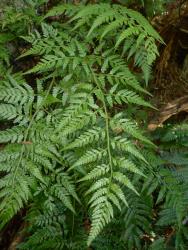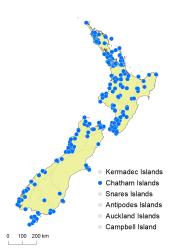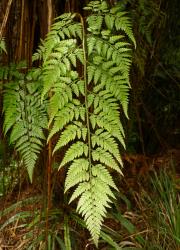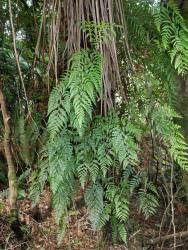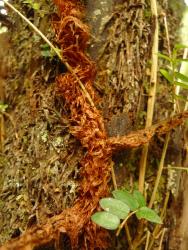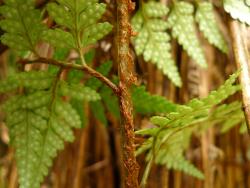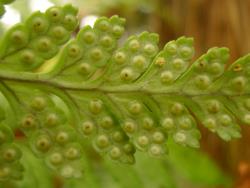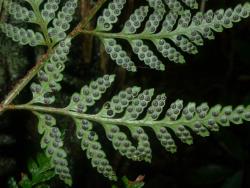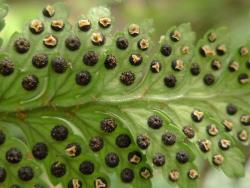- ≡ Polypodium adiantiforme G.Forst., Fl. Ins. Austr. 82 (1786)
- ≡ Polystichum adiantiforme (G.Forst.) J.Sm., Hist. Fil. 220 (1875)
- ≡ Dryopteris adiantiformis (G.Forst.) Kuntze, Revis. Gen. Pl. 3(3), 378 (1898)
- = Polypodium coriaceum Sw., Prodr. [Swartz] 133 (1788)
- ≡ Aspidium coriaceum (Sw.) Sw., J. Bot. (Schrader) 1800(2): 40 (1801)
- ≡ Tectaria coriacea (Sw.) Link, Hort. Reg. Bot. Berol. 2, 127 (1833)
- ≡ Hypopeltis coriacea (Sw.) Bory, Voy. Indes Or., Bot. 70 (1833)
- ≡ Polystichum coriaceum (Sw.) Schott, Gen. Fil. t. 9 (1834)
- = Aspidium capense Willd., Sp. Pl. 5(1), 267 (1810)
- ≡ Polystichum capense (Willd.) J.Sm., Companion Bot. Mag. New Ser. 2: 35 (1846)
- = Aspidium cunninghamii Colenso, Tasmanian J. Nat. Sci. 1: 379 (1843)
- = Aspidium cunninghamianum Colenso, Tasmanian J. Nat. Sci. 2: 166 (1845)
Rhizomes long-creeping, up to 340 mm long (in herbarium material), 3–6 mm diameter, densely scaly. Rhizome scales narrowly ovate to ovate, 5.5–12 mm long, 1.4–2.4 mm wide, chestnut-brown, concolorous or with darker centres, margins entire or minutely toothed. Fronds 85–1020 mm long. Stipes 5–540 mm long, pale or yellow-brown, scaly, especially near junction with rhizome; scales narrowly ovate, chestnut-brown or sometimes with darker centres, up to 10 mm long and 2 mm wide. Rachises yellow-brown, sulcate, narrowly winged distally, scaly; scales scattered throughout, narrowly ovate, chestnut-brown, up to 6 mm long and 1 mm wide. Laminae 2–3-pinnate proximally, ovate, 55–560 mm long, 24–300 mm wide, shining bright green or yellow-green adaxially, paler dull green abaxially, coriaceous, bearing ovate or narrowly ovate scales on abaxial costae, almost glabrous adaxially; bearing tiny, sessile, flattened, reddish or yellowish glands surrounded by shiny patches, mainly on the abaxial surface (sometimes lost with age). Primary pinnae in 5–18 pairs below pinnatifid apex, widely spaced especially proximally, narrowly ovate distally, ovate proximally; the longest at or near the base, 16–300 mm long, 10–150 mm wide, apices acute to acuminate, bases stalked, costae narrowly winged for most of their length. Acroscopic secondary pinnae decreasing in length along the primary pinna to the distal end; the basal basiscopic secondary pinna the longest, oblong or narrowly ovate, 8–100 mm long, 4–45 mm wide, apices acute or obtuse, bases stalked or adnate, margins incised or divided into tertiary segments. Tertiary segments oblong, the longest 5–33 mm long, 3–10 mm wide, apices obtuse or rounded, margins ± entire or divided ½ way to midrib, bases stalked. Sori round, medial; indusia round, 1.2–2.2 mm diameter, with dark centres, glabrous.
Rumohra adiantiformis is recognised by its terrestrial or climbing habit, long-creeping rhizomes densely covered in conspicuous chestnut-brown scales, 2–3-pinnate laminae bearing scales and tiny red or yellow glands on the abaxial surface, and conspicuous round sori protected by round indusia with dark centres.
North Island: Northland, Auckland, Volcanic Plateau, Gisborne, Taranaki, Southern North Island.
South Island: Western Nelson, Sounds-Nelson, Marlborough, Canterbury, Westland, Otago, Southland, Fiordland.
Chatham Islands, Stewart Island.
Altitudinal range: 0–975 m.
Rumohra adiantiformis occurs in lowland and montane areas throughout the North Island from Kaitāia to Wellington, although rare along the east coast. It ranges from sea level to 975 m on Mt Hauhungatahi in the central North Island. In the South Island it occurs more frequently west of the main divide from the Marlborough Sounds and north-west Nelson to Fiordland and Southland, with scattered populations on the east coast. It is absent from the drier parts of inland Marlborough, Canterbury and Otago. It grows from near sea level, up to 550 m on Martyr Spur in south Westland. It extends also to Stewart Island and the Chatham Islands.
Also Bermuda and Greater Antilles (Proctor 1985), Argentina, Bolivia, Brazil, Chile, Peru, Uruguay and Venezuela, Galapagos Islands, Juan Fernandez Island (Sundue et al. 2013; Bauret et al. 2017), southern Africa and Madagascar (Roux 2009), Australia (Queensland, New South Wales, Victoria, Tasmania) and Papua New Guinea (Jones 1998).
Rumohra adiantiformis occurs in kauri, podocarp, broadleaved and beech forest, in kānuka and coastal scrub, under Pinus radiata, among flax and bracken, and rarely in dune hollows and on swamp margins amongst rushes. It is usually a climbing epiphyte, but also grows on fallen logs, and on the ground amongst roots and boulders, at the base of tree trunks, in gullies, on rock faces, and on forest margins. It has been recorded growing epiphytically on Cyathea dealbata, C. smithii, Dicksonia fibrosa and D. squarrosa.
n = 41 (Brownlie 1958).
Mazumdar et al. (2019) lectotypified Polypodium adianthoides Burm.f. with a specimen in G‑PREL collected by Pryon in Indonesia. The collection is a specimen of Rumohra adiantiformis (Mazumdar 2019, fig. 4) and hence Polypodium adianthoides (Burman 1768) predates P. adiantiforme (Forster 1786), the basionym of Rumohra adiantiformis. In order to avoid an unfortunate nomenclatural change to a well-known and widespread fern, Mazumdar (2019) has proposed conserving Forster’s name over Burman’s.
The names Polypodium coriaceum Sw. and Aspidium capense Willd., and combinations based on them, were used in earlier New Zealand Floras but are currently regarded as synonyms of Rumohra adiantiformis, with types from Jamaica and South Africa, respectively.
Bauret et al. (2017) showed that Rumohra adiantiformis from across its geographical range was “grossly polyphyletic”. They recognised six geographically structured and supported lineages in the Neotropics, southern South America, South Africa, the Comoros, the Western Indian Ocean islands (Madagascar, Mascarenes and Seychelles), and Australasia (Australia, New Zealand and Papua New Guinea). However, they found no distinctive morphological characters to distinguish these lineages, and, until further in-depth investigation is undertaken, recognised them as cryptic species within Rumohra adiantiformis. The type of R. adiantiformis was collected in New Zealand and, even if six different species are subsequently recognised, the name will continue to apply to the Australasian lineage. However, the basionyms Polypodium coriaceum and Aspidium capense probably relate to other lineages.



